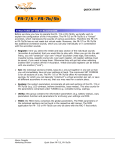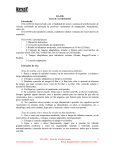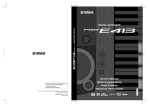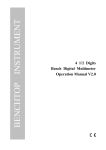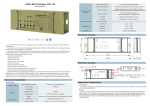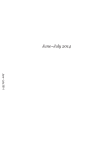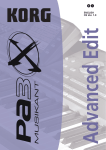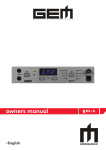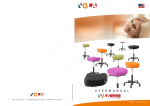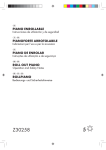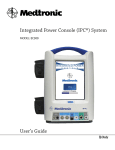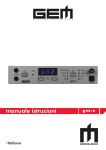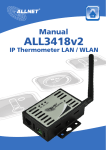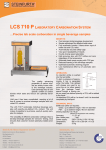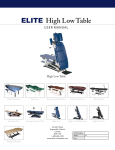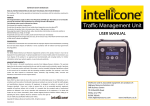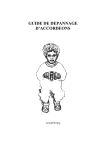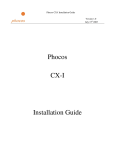Download Anleitung DA-7 1.8 Peter
Transcript
Swiss precision Digital Accordion Version 1.8 user manual Accordeon factory J. Gwerder & Son Steinen (Switzerland) your agent: Peter Canziani 30 Herekiekiestreet, Turangi – New Zealand Phone: 07 386 7775 Fax: 07 386 7770 E-Mail: [email protected] -2- Contents Title Welcome Security issues Copyright advise Contents of order Basic operation Sound select Save and load registers Styles (auto accompaniment) Display instructions Setup basic settings - treble, bass, accord sensoric - auto off timer - display brightness - keyboard layout - volume of the accompaniment Connections Page -2– -3– -3– -3– -4– -5– -6– -7– -8– -9– - 10 – Welcome Congratulations to your choice of a Gwerder Digital Accordion We are sure, that after you have read this manual, you will be able to manage this superb instrument without any problems and you will get the best out of it. This Digital Accordion is the product of 8 years experience in the field of electronic keyboard instruments for live musical performances. Our digital accordions have been able to compete in recent years in the rough live operation successfully and reliably, but also for musicians who arrange their own pieces. It’s also excellent for students who want to practice at rest with the headphones. The accordion has a full range of advanced operations, but is very easy to handle, so you can start making music without much preparation. We wish you lots of fun with your digital accordion. Safety measures -3- - Read the instructions carefully. - Make sure that the power cord is not bent, twisted or squeezed. - Don’t put the instrument to extreme conditions such as high humidity or rain, high temperatures, direct sunlight, excessive vibration or dust. - Never touch the power supply/charger with wet hands. - Either the accordion nor the adapter/charger may be altered in any way. - Do not attempt repairs on the instrument. To avoid electrical shock, do not open the casing. Otherwise your warranty will expire. - The instrument can be very loud. Be considerate of your environment. - Note for models with built-in Ni-MH battery: It may only be connected with our original charger. The built-in Ni-MH battery is very sensitive, but requires no major attention, as our charger monitors the entire loading process. Failure to observe this requirement will void the warrenty. - The power supply/charger will not be set to the voltage. It has an automatic multi-area input (100 – 240 V 50/60Hz) Copyright notice The samples and sounds of this instrument are protected by copyright. Any reproduction or processing of samples or the disclosure to third parties is prohibited. Contents of Delivery Quantity 1 1 1 1 Description Digital Accordion Charger User manual Warranty Optional extras are: footpedal, headphones, midi cable, USB adapter, case, backpack -4- Basic Operation Digital MAX Lautstärke Sound processing VOLUME MIN Balance Wheel R right = treble left = bass/chord BALANCE Echo ECHO clockwise = + counter-clockwise = select by pressing the dial L MAX MIN Bellows Dynamik EASY STYLES AKKORD 1 BASS 1 DISKANT 1 ..SETUP ..AKKORD 2 ..BASS 2 ..DISKANT 2 BELLOW STRONG Treble 1 By short touching you come into the selection menu of the first voice of the treble keyboard (melody). …Treble 2 Holding down long you come into the second voice of the treble keyboard (melody) Bass 1 By short touching you come into the selection menu of the first voice of the bass keyboard (bass / alternating bass) ...Bass 2 Holding down long you come into the second voice of the bass keyboard (bass / alternating bass) Chord 1 By short touching you come into the selection menu of the first voice of the chord keyboard (accompanying bass). ...Chord 2 Holding down long you come into the second voice of the chord keyboard (accompanying bass) Style By short touching you come into the selection menu of the styles (accompanying rhythms and demos) …Setup Holding down long you come into the setup-menu for all basic settings (only for experienced users) Bellows dynamics: constant 100% = volume always minimum 100%, can be raised with bellows to 127. The same also with permanent 75% or 25%. Extreme powerful, powerful, normal, light, extreme light. That’s how to set the bellows dynamic curve - from 0 to 127 expression. Instrument (sound) selection The choice or change of the sound of an instrument is always the same operation, whether melody, bass or chord. 1. Select with one of the 3 buttons (treble, bass, chord) the sound you wish to change (refer to page 4 – 1. and 2. voice) 2. You can check all instrument sounds with the wheel or select direct with the treble registerbuttons (register 1-10 (10=0), 11-30 deletes the input. the sound to be changed is always displayed MAX VOLUME MIN R BALANCE L MAX ECHO digit of the chosen Diskant 1. Stimme 153 instrument sound Akkordeon (142-174) Excelsior Akkord group of the chosen Gola T instrument sound Gola T+M+MM Gola T+M+H MIN EASY STYLES AKKORD 1 BASS 1 DISKANT 1 ..SETUP ..AKKORD 2 ..BASS 2 ..DISKANT 2 BELLOW STRONG 3. Have you chosen the suitable sound, confirm it by pressing the wheel. 4. You will come automatically to another menu. MAX VOLUME MIN R BALANCE L Diskant 1. Stimme 153 Gola T Lautstärke 100 MAX ECHO MIN EASY STYLES AKKORD 1 BASS 1 DISKANT 1 ..SETUP ..AKKORD 2 ..BASS 2 ..DISKANT 2 BELLOW STRONG 5. You can now choose the volume of the previously selected sound by the wheel. 6. You confirm here again the volume by pressing the wheel. 7. After confirming the volume, you can select the octave change by pressing the wheel to confirm it. 8. Now you come back to the main menu automatically. -5- Save and storing of sounds -6- If the instrument is adjusted to your taste you can store it in bank “B”. Push the desired register on your accordion and release the button only when a sound (Ping) occures. Now all settings will be overwritten on the memory space in “B”. This process can be repeated on all memory spaces as often as you wish. Attention: When switching on the accordion, the parameter of memory space 1 will be selected automatically. The bank “A” is set by the producer and can not be changed. So you have the possibility of 60 different settings. Loading Registers + Masterbar With a short touch of the desired register (memory space) only the 1. treble voice is loaded and is ready to be played. With two short pushes of the desired register, you will get the entire memory space of all the 6 parameters (treble 1+2, bass 1+2, chord 1+2. Please note: switching on the accordion, it will always load the parameter of memory space position 1 A. With the masterbar you can switch between the two previously selected registers back and forth. It’s in each case only the first treble voice chosen. The bass voices remain unchanged. MIDI-Out channels The MIDI-Out channels are assigned as follows: Channel 1 Channel 2 Channel 3 Channel 4 Channel 5 Channel 6 treble chord bass treble chord bass 1. voice 1. voice 1. voice 2. voice 2. voice 2. voice Styles (accompaniment) -7- Select as descriped the desired style. Start: Preparation by pressing the start button (bass register). Final start by pressing the chord tone. Intro / Start: Press Intro first and then Start, so style will count down first. Final start by pressing the chord tone. Variation: By pressing the “variation” it will always change to the next variation (A to B etc.) Ending: By pressing the ending button, the style will end accordingly – not immediately, but with the beat. Press the accord button two times, the style will also end. Speed: Is the accompaniment in use, the speed can be changed by the dial wheel. Drums / Solo: Changes to “drums only” and back again. Volume + / So you can choose the volume of the accompaniment. Ending – immediately By pressing the dial wheel, style ends immediately, but is still active charged and will end only by pressing the dial wheel twice. Only after this process, you can select a new style. Attention: The 4 buttons (styles, chord, bass, treble) are disabled while style is active. STYLE VOLUME + INTRO START VARIATION + ENDING DRUMS / SOLO Chin Knee STYLE VOLUME - -8- Display Guide The Gwerder Digital Accordion has a graphic display which is illuminated. Below we explain what is where to see in the main menu. The contents change of course, depending on what you have selected. display of the actual speed of the styles or demos D/S = drums solo active D/S D=Steirische 2 Speed B=Bariton 120 A=Trompete Volks. Polka 1 -> Main A 1 display of the active/selected style or demo and also the variation D/S D=Steirische 2 Tempo B=Bariton 120 A=Trompete Volks. Polka 1 -> Main A 1 here you see the active/selected register with number 27 of bank “A” as well as change register 1 (Masterbar) A27 A27 D/S D=Steirische 2 Tempo B=Bariton 120 A=Trompete Volks. Polka 1 -> Main A 1 A27 D/S D=Steirische 2 Tempo B=Bariton 120 A=Trompete Volks. Polka 1 -> Main A 1 A27 D/S D=Steirische 2 Tempo B=Bariton 120 A=Trompete Volks. Polka 1 -> Main A 1 display of the current battery level (in this example 80%) display of the current selected instruments of the 1. voice A27 D/S D=Steirische 2 briefly repeatedIn this example Tempo B=Bariton A=Trompete 120 the style Volks. Polka 1 is selected. With speed 120. Volks. Polka 1 The register is A 27. 1st treble voice is Steirische 2, -> Main A 1st bass voice is Bariton and 1st accord voice is trumpet. 1 A27 Battery life is 80% (8 hours left to play). The Masterbar causes the change between treble 1 and 27. Setup (*only for experienced users) -9- Press the SETUP button until you get into the setup menu. The various parameters/settings change by turning the wheel. - treble 1 responds to (volume of the 1st voice of treble keyboard) - treble 2 responds to (volume ot the 2nd voice of treble keyboard) - bass 1 responds to (volume of the 1st voice of bass keyboard) - bass 2 responds to (volume of the 2nd voice ot bass keyboard) - chord 1 responds to (volume of the 1st voice ot the chord keyboard) - chord 2 responds to (volume of the 2nd voice of the chord keyboard) Would you like to change the volume, press the dial wheel. The current value will be noted in white. Now you can change the desired volume with the dial wheel. Have you chosen the desired parameter, press the dial wheel again. The value is now loaded and the white display disappears. The meaning of the parameters is as follows: - Pedal normal (you determine the volume of the actual voice with the pedal. If no pedal is connected, you adjust the volume level automatically with the bellows.) - Pedal inverted (you determine the volume of the actual voice with the pedal, but vice versa.) - Bellows dynamic (you determine the volume of the actual voice with the bellows) - without dynamics (the volume is always identical) - Auto power off timer (always switched on – 10, 15 or 20 min) - Display brightness (luminosity of the LCD display 0 – 127) - Treble keyboard - chromatic forward (C) - chromatic reverse (B) - diatonic Schwyzerörgeli - diatonic Club version (keyboard layout of the treble) - Bass keyboard (keyboard layout of the bass) - forward 2 bass rows, - forward 3 bass rows - reverse 2 bass rows, - reverse 2 bass rows, - free bass minor 3rd, -free bass bajan, -free bass 5th, - free bass north europe, -diatonic club version - Style volume = - from the pedal - constant (volume control of the accompaniment) (You determine the volume of the accompaniment with the pedal) (the style volume stays always identical) To exit the setup menu, press the setup button Connections -10- Charging Jack (it may only be used our charger. Charge only if the instrument is turned off!) N I AR MH G ER Midi IN ID II N C H Midi OUT IO U T M Pedal PE D AL M ID Headphones (Stereo) O N ES Line OUT (Stereo) T PH switch OFF* O N O FF LI N E O U switch ON* * press at least 0.5 seconds










